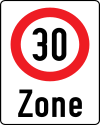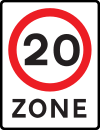30 km/h zone


30 km/h zones (30 kilometres per hour zones) and the similar 20 mph zones (20 miles per hour zones) are forms of speed management used across areas of urban roads in some jurisdictions as an alternative to normal speed limits. The nominal maximum speed limits in these zones are 30 kilometres per hour (19 mph) and 20 miles per hour (32 km/h) respectively. Although these zones do have the nominal speed limit posted, speeds are generally ensured by the use of traffic calming (physical or psychological) measures, though limits with signs and lines only are increasingly used in the UK.[1] [2]
Reasons for implementation
These zones are generally introduced in areas, particularly residential areas, in an attempt to keep road traffic speeds down to a safe level. The philosophy behind such zones is that the streets in the zone are public space, and they seek to help strike a balance between the realities of an urban area bustling with pedestrian activity and the circulatory function of the roadways. Streets in these zones are considered to be a space for people who live, work, play and study in the area, not for people who cross the zone to get somewhere else. The theory is to reduce rat running while improving the safety and quality of life in the area.
Research has shown that reducing driver speeds in built-up areas reduce injuries for all road users, including motorists, bicyclists, and pedestrians. The link between vehicle speed and pedestrian crash severity has been established by research studies, with crash severity increasing as a function of motor vehicle speeds. If a vehicle hits a pedestrian while traveling 15 miles per hour (24 km/h) most pedestrians will survive a crash, often sustaining only minor injuries. Minor increases in impact speed have been shown to have a profound effect on crash severity. At 25 miles per hour (40 km/h), almost all crashes result in severe injuries and roughly half are fatal; and at 40 miles per hour (64 km/h), fully 90% of crashes are fatal. The dramatic differences in fatality rates are a key part of the theory behind 20 mph and 30 km/h zones.[3] Other studies have revealed that lower speeds reduce community severance caused by high speed roads in neighbourhoods, i.e. there is more neighborhood interaction and community cohesion when speeds are reduced to 30 km/h.[4]
Objectives
The objectives of the implementation of zones are to help:
- Provide safe street crossings
- Improve the quality of life
- Increase levels of walking and cycling
- Reduce obesity through increased active living
- Reduce rat running and cut through traffic
- Reducing motor vehicle traffic volumes and speeds
- To reduce road crash rates, injuries and fatalities to all road users
- Reduce greenhouse gas emissions, air pollution and noise pollution
- Foment an area where pedestrians, cyclists and motorists coexist safely and comfortably
- Develop public space that is open and safe for everyone, including people with disabilities
- Increase the space available for walking, biking, and people on the street to eat, play and enjoy life
- Provide a safe area for children in school zones
- Increase real estate values of local homes and businesses
- Increase the economic vitality of the area
- Strengthen the sense of community[5]
Benefits
Compared to normal signed but unenforced speed limits, these type of speed zone generally deliver the required traffic speeds because of their traffic calming aspects.
Disadvantages
Physical calming measures can be uncomfortable for motor vehicle occupants and can impede emergency service vehicles. Compared to normal signed limits, zones can be expensive because of the engineering of traffic calming measures they may require. Noise, vibration and pollution can be caused by traffic slowing down and speeding up between the calming measures, though with the installation of average speed cameras in some areas, this is far less of an issue.
Prevalence
Europe
In European countries 30 km/h zones have been used widely. On September 1, 1992, the city of Graz, Austria, became the first European city to implement a city-wide 30 km/h limit on all roads except its largest. Significant 30 km/h zones are ubiquitous across the Netherlands. In Switzerland 30 km/h zones have been allowed by law since 1989 and they were first established in Zurich in 1991.[6]
A network of 67 European NGOs organised a European Citizen's Initiative (ECI) "30kmh - making streets liveable" collected signatures of support for a 30 km/h speed limit as the normal limit for the European Union. 50 km/h speed limits shall become exceptions. Local authorities shall be able to decide on these exceptions and set other speed limits on their street network. [7]
In the United Kingdom, 20 mph speed limits are gaining popularity. There is significant action across the UK, both by organisations and local councils, to implement more 20 mph limits and zones in local communities.[8] 20's Plenty for Us list populations in UK local authorities committed to wide-area 20mph limits at over 15 million people at March 2016 with over half of the largest UK 40 urban authorities having agreed a Total 20mph policy.
United States
In the US, 20 mph (32 km/h) speed limits exist along linear routes, but are slow to catch on for area-wide implementation. New York City is leading the way with neighborhood-scale 20 mph zones and is currently re-engineering 60 mi (100 km) of streets per year for conversion to 20 mph zones.[9]
Ten US states already allow 15 mph (24 km/h) or 20 mph (32 km/h) speed limits for linear routes, as follows:
- Alaska stipulates 15 mph (24 km/h) speed limits in alleys and 20 mph (32 km/h) limits in business districts.
- In Delaware school zones have 20 mph (32 km/h) speed limits.
- Florida has school zones which usually have 10 mph (16 km/h) to 20 mph (32 km/h) limits. Most use signing and flashing yellow lights during school times, but there is debate surrounding the efficacy of these measures.
- Massachusetts has set their default speed limit at 15 mph (24 km/h) in the vicinity of a mobile vendor with flashing yellow lights (such as an Ice Cream Truck) and at 20 mph (32 km/h) in a school zone when children are present.
- In North Carolina, the Central Business Districts (CBDs) have a statutory speed limit of 20 mph (32 km/h) unless otherwise posted. They use "Reduce Speed Ahead" signage instead of the more common "Reduced Speed Ahead" signage.
- In Oregon, rather than having a “when children are present” speed limit, they have a 20 mph (32 km/h) speed limit with a time-of-day system, usually school days, 7 a.m. to 5 p.m. The speed limit is for school roads with posted speeds of 30 mph (48 km/h) or below.
- Pennsylvania generally uses 15 mph (24 km/h) speed limits for school zones during arrival and departure times.
- In Rhode Island the default speed limit is 20 mph (32 km/h) within 300 ft (90 m) of a school, which starts to emulate a 20 mph (32 km/h) zone but is not an area-wide speed limit.
- In West Virginia school zones have a statutory speed limit of 15 mph (24 km/h), except for roads with a speed limit of 55 mph (89 km/h) or higher, which have an advisory speed of 35 mph (56 km/h) in school zones when children are present. A school zone includes 200 ft (60 m) adjacent to the school (or school road) in both directions.
- Wisconsin has a default speed limit of 15 mph (24 km/h) in school zones, near parks with children, and in alleyways.[10]
Mexico
Mexican cities which have established 30 km/h (19 mph) zones (Zonas 30):
- Monterrey, Nuevo León: in Barrio Antiguo.[11]
- Guadalajara, Jalisco: in Historic Downtown.[12]
- Zapopan, Jalisco: in Historic Downtown.[13]
- Los Mochis, Sinaloa: in Downtown.[14]
References
- ↑ Elizabeth Press (2010-08-30). "No Need for Speed: 20′s Plenty for Us". Streetfilms. Retrieved 2011-11-27.
- ↑ "Setting Local Speed Limits". UK Department for Transport. 2013-01-01. Retrieved 2015-04-28.
- ↑ Street Design: The Secret to Great Cities and Towns. John Wiley & Sons. 2013. Retrieved 2014-08-18.
- ↑ Joshua Hart. "Driven To Excess: A Study of Motor Vehicle Impacts on Three Streets in Bristol UK" (PDF). Walk21. Retrieved 2011-11-27.
- ↑ "20's Plenty for Us". Retrieved 2016-03-17.
- ↑ "Tempo 30" (in German). www.stadt-zuerich.ch. Retrieved 2011-11-27.
- ↑ "European Citizens´Initiative "30 km/h - making streets liveable!"".
- ↑ "20's Plenty for Us". Retrieved 17 March 2016.
- ↑ Fried, Ben (2010-08-16). "NYCDOT Releases Landmark Ped Safety Study, Will Pilot 20 MPH Zones | Streetsblog New York City". Streetsblog.org. Retrieved 2011-11-27.
- ↑ "Chapter 346 – Rules of the Road" (PDF). Wisconsin State Legislature. Retrieved 2011-11-27.
- ↑ "Declara Monterrey Zona 30 a calle Morelos" (in Spanish). Multimedios. Retrieved 2015-07-16.
- ↑ "Zona 30 fue inaugurada en GDL" (in Spanish). Unión Jalisco. Retrieved 2015-07-16.
- ↑ "Este mes quedará terminada la Zona 30 y el programa Mi Bici en Zapopan" (in Spanish). Meganoticias. Retrieved 2015-07-16.
- ↑ "Proyecto Zona 30, por buen camino" (in Spanish). El Debate. Retrieved 2015-07-16.